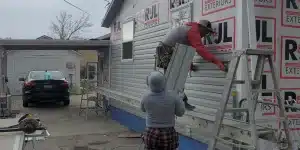Embarking on a DIY project for your home can be both exciting and daunting. At Utah Siding & Exteriors, we understand the pride that comes with improving your home by yourself. However, when it comes to installing your own siding, there are crucial do’s and don’ts to consider ensuring your home’s exterior is not just beautiful, but also durable and properly protected. This article is designed to guide homeowners through the process, making Siding Installation less intimidating and more successful.
Understanding Your Materials
Before diving into your siding project, it’s essential to understand the materials you’ll be working with. Different materials, such as vinyl, wood, or fiber cement, each have their unique characteristics and installation requirements. For example, while Vinyl Siding is known for its durability and ease of maintenance, Fiber Cement Siding offers excellent resistance to fire and pests. By familiarizing yourself with the properties of your chosen materials, you can better prepare for the installation process, ensuring that your siding not only looks great but stands up to the elements as well.
Additionally, consider the climate in your region. Materials that are well-suited for one climate may not perform as well in another. For instance, vinyl siding can become brittle in extreme cold, while Wood Siding may struggle in very humid environments. Choosing the right material for your local climate is key to long-term satisfaction and durability.
Preparation is Key
Proper preparation cannot be overstated when it comes to DIY siding installation. This starts with thoroughly reading and understanding the installation manuals and local building codes. Ignoring these can lead to improper installation, which may void warranties or, worse, result in damage to your home. Equally important is preparing the wall surface. The siding must be installed on a flat, clean surface, so any repairs or leveling should be addressed before the siding goes up.
Next, gather all necessary tools and equipment. Running out to the hardware store mid-project can halt your momentum and frustrate your DIY experience. Make a checklist of all recommended tools and materials outlined in your installation guide and ensure you have everything before you start.
Measuring and Calculating
One of the critical steps in siding installation is measuring your home and calculating the amount of siding you’ll need. It’s better to overestimate slightly than to find yourself a few panels short at the end of your project. Take detailed measurements of each wall and factor in windows, doors, and any other areas that won’t be covered with siding.
Additionally, remember to account for waste and mistakes, especially if you’re a first-time installer. A good rule of thumb is to add an extra 10% to your total square footage calculations. This buffer can save you from unexpected runs to the store, keeping your project on track.
Choosing the Right Tools
The success of your DIY siding installation heavily relies on having the right tools for the job. While the specific tools can vary depending on the siding material, some common tools include a hammer, tape measure, level, utility knife, and tin snips. Investing in a few quality tools can make the installation process smoother and faster.
For those installing vinyl siding, a vinyl siding zip tool is invaluable for fitting and removing panels. And for cutting fiber cement siding, a specialized saw blade designed to handle its tough composition can save a lot of time and effort. Remember, the right tools not only ease the installation process but also help to achieve a professional-looking finish.
Installation Techniques to Master
Each type of siding demands specific installation techniques to ensure it performs effectively. For instance, vinyl siding needs to be hung loosely to accommodate for thermal expansion and contraction. Nailing it too tightly can lead to warping or buckling. Conversely, fiber cement siding requires precise nailing without damaging the material. Understanding these nuances is crucial for a successful installation.
Additionally, paying attention to the manufacturer’s guidelines cannot be overlooked. These guidelines are designed to address the specific needs of their products and provide valuable insights into the best practices for installation. Ignoring these recommendations can result in poor performance and lifespan of your siding.
Measure Twice, Cut Once
- Accurate Measurements: Ensuring you have the correct measurements before cutting any materials will save you time and resources. Double-check dimensions to avoid unnecessary waste.
- Marking Clearly: Use a carpenter’s pencil or chalk line for clear and visible markings on your siding material. This makes for precise cuts and fitting.
- Using the Right Blade: Different siding materials require different blades for cutting. Make sure you use the appropriate blade to ensure clean cuts.
- Steady Hand: Whether using a circular saw, jigsaw, or hand saw, a steady hand is crucial for straight and accurate cuts. Take your time to achieve the best result.
- Eye Protection: Always wear safety glasses or goggles when cutting siding materials. Protecting your eyes from dust and debris is paramount.
Dos and Don’ts at a Glance
| Do | Don’t | Why |
|---|---|---|
| Follow manufacturer’s guidelines | Ignore installation instructions | Ensures warranty remains valid and installation is correct |
| Prepare your worksite | Rush into installation | Prevents potential issues and mistakes |
| Use the right tools | Make do with what you have | Facilitates proper installation and safety |
| Check local building codes | Skip permits if required | Ensures your project is up to standard and legal |
| Measure and calculate accurately | Guesstimate materials needed | Avoids running out of materials and overbuying |
Finishing Touches Matter
As you approach the completion of your siding project, paying attention to the finishing touches is vital. These include properly installing trims, soffits, and fascias. Not only do these elements add to the aesthetic appeal of your home, but they also serve functional purposes like sealing out moisture and providing ventilation. Ensuring these components are correctly installed will significantly enhance the overall look and performance of your siding.
Moreover, don’t forget to caulk and seal any gaps. This step is critical in preventing water damage and ensuring your home is well insulated. Choose a high-quality, exterior-grade sealant for the best results. A well-sealed home is more energy-efficient, saving you money in the long run.
When to Call a Professional
Despite your best efforts, there may come a point in your siding installation project where calling in a professional is the wise choice. This could be due to unexpected challenges, such as significant structural damage uncovered during the project, or simply the realization that the project is beyond your current skill level. There’s no shame in seeking assistance; it’s crucial to ensure the job is done right to protect your home.
At Utah Siding & Exteriors, we’re here to help. Whether you’ve hit a snag in your DIY project or decide from the outset that you’d prefer professional installation, our team of experts is ready to step in. We pride ourselves on our craftsmanship and customer service, ensuring a seamless and satisfying experience from start to finish.
In Conclusion
Embarking on a DIY siding installation project can be a rewarding endeavor, yielding not just a more beautiful home exterior, but also the satisfaction of having done it yourself. However, it’s essential to approach the project with caution, armed with the right knowledge, tools, and techniques. And remember, if you ever feel in over your head, we’re just a call away at 801-509-9241 or you can Request a Free Quote. The beauty and durability of your home’s exterior are within reach, and we at Utah Siding & Exteriors are here to support you every step of the way.




